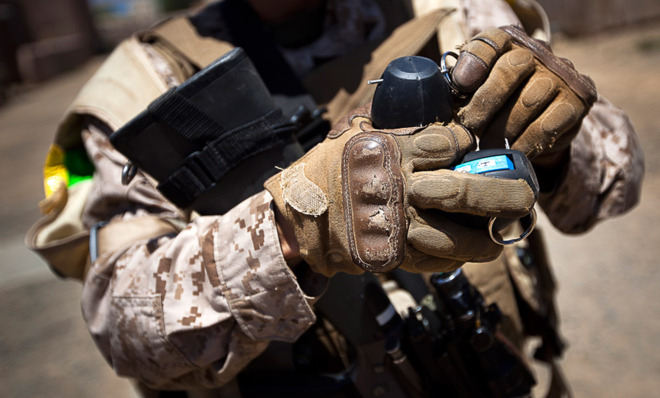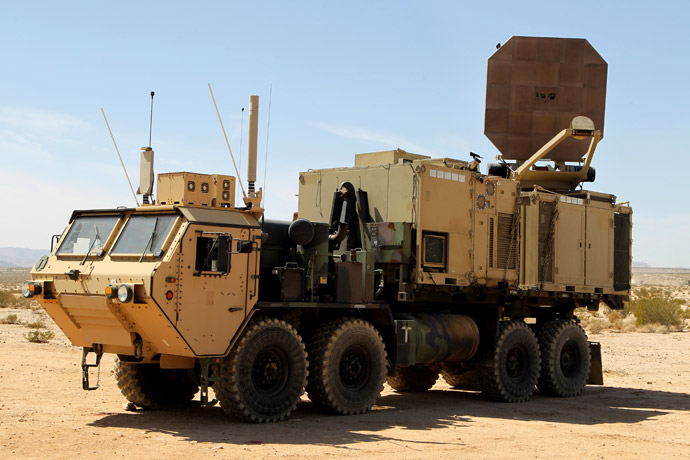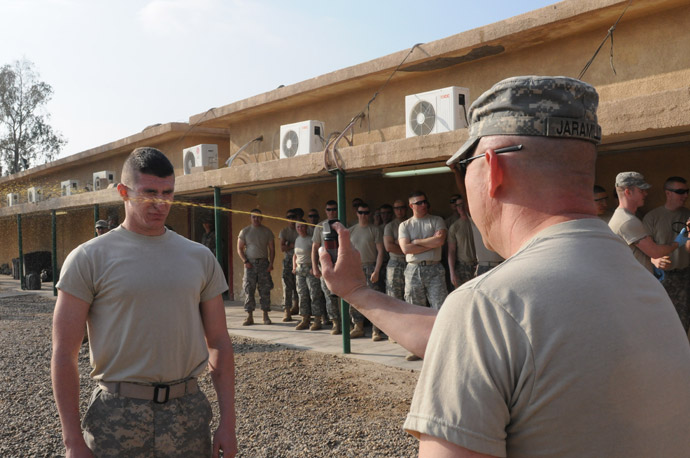The U.S. military has pain rays and stun guns. So why aren't they being used?
The military goes on the offensive to educate troops about non-lethal weapons


In the early days of the Iraq War, the U.S. military pumped millions of dollars into non-lethal weapons projects intended to stop people without killing them.
There was the "pain ray," designed to force people to move by aiming agonizing millimeter waves at them. There were electroshock weapons such as the Taser, purchased to incapacitate people at close ranges without shooting them. And there were a variety of other non-lethal bullets, grenades, slippery foams, and laser dazzlers acquired to drive away or stop potential combatants without resorting to hot lead sprayed from a rifle.
And that was just the tip of the iceberg.
Subscribe to The Week
Escape your echo chamber. Get the facts behind the news, plus analysis from multiple perspectives.

Sign up for The Week's Free Newsletters
From our morning news briefing to a weekly Good News Newsletter, get the best of The Week delivered directly to your inbox.
From our morning news briefing to a weekly Good News Newsletter, get the best of The Week delivered directly to your inbox.
A decade later, however, the Joint Nonlethal Weapons Program established by the Pentagon is moving forward with decidedly mixed returns: Its technology was rarely used in the conflicts in Iraq or Afghanistan, according to a 2009 report by Congress's investigative agency, the Government Accountability Office. Since then, the directorate overseeing non-lethal weapons has improved its planning and organization, the GAO subsequently found, but officials with the organization say they are still fighting an uphill battle to get non-lethal weapons fielded and used.
There is perhaps no greater example of this than the Active Denial System, the directed-energy "pain ray" weapon that turns electricity into a painful ray of millimeter waves targeting people up to 1,000 meters away.

The device's existence was first disclosed in 2001, but it was not deployed until it reached troops in Afghanistan in 2010. Even then, it was recalled from the war zone quickly without ever being used in combat amid criticism that using pain rays would yield propaganda victories for the Taliban — even if the alternative was deadly hot lead fired by U.S. troops.
Brian Long, the Active Denial System's program manager, said that in the last few years, officials with the Joint Non-Lethal Weapons Program have "found kind of dichotomy" in the military. On one hand, commanders want to reduce civilian casualties, and want them quickly after they are requested. On the other hand, many units have been unwilling to spend the time training their troops to use them, even for situations where they hypothetically could help.
A free daily email with the biggest news stories of the day – and the best features from TheWeek.com
"What we kind of realized was that despite the fielding, there was a sense that these things weren't really useful," Long said in an interview at Quantico, Va., where the Joint Non-Lethal Weapons Directorate is based. "There was a general unfamiliarity with these things."
Another example is the Taser. After the fall of Baghdad in 2003, some U.S. units began carrying the electroshock device as an option to subdue potential adversaries or prisoners. They ultimately were used by the Air Force and Army, but mostly for specific niche missions, like security checkpoint enforcement.
The Marine Corps also owned obtained a small amount of Tasers, but did not use them in part due to concerns about how they would be perceived in places like Iraq, a Marine spokesman later said. The Marine Corps did not approve guidelines for their use until 2008, and still has not bought them in large quantities. The non-lethal weapons program says in presentations only that the Marine Corps is "authorized" to buy them if it wants them.

The use of non-lethal weapons also has been hindered by the range of capabilities of what is available.
In one example, there are 12-gauge shotgun rounds that are available to dispense rubber bullets and other crowd control measures, said Kevin Swenson, the non-lethal program's acquisition division chief. But the current versions have specific ranges at which they are effective — or potentially deadly if used too close to targets. The limitations mean that troops in the field must carry multiple rounds for different uses, and think twice before using the rubber version.
"From a fiscal pressure standpoint, what we want to do is get rid of three or four rounds, and replace them with a single round that has a very close [minimum] safe range and a far effective range, increasing that sweet-spot effective range," Swenson said.
Still, the non-lethal weapons program continues to develop a variety of equipment that could one day provide U.S. forces with more alternatives to deadly force. In one example, it's exploring how to improve the technology it uses to stop vehicles. It currently has available a couple of systems that use either spikes to deflate tires or nets that wrap around a car's axles. But the equipment is either heavy, can only be used a single time, or both, officials said.
One alternative under development would use directed beams of energy to incapacitate threatening vehicles or vessels, but that it isn't ready for primetime yet.
The military also has gone on the offensive to educate the troops about non-lethal weapons. In one example, it has held a series of demonstrations to show how the gear they have developed can be used. The two major ones in 2013 were held at Twentynine Palms, Calif., and Joint Base Langley-Eustis in Hampton, Va., in September. At Twentynine Palms, Marines used non-lethal weapons to demonstrate how they could defend a base's perimeter. At Langley-Eustis, the non-lethal program demonstrated how Active-Denial System's pain rays could be used from Army landing craft to target people on one vessel from another, Long said.
Despite the setbacks, there is a long-term home for non-lethal weapons in the military, said retired Marine Gen. Anthony Zinni, who led U.S. operations in the Middle East before retiring in 2000. He is credited with seeking and deploying with a variety of non-lethal weapons to Somalia in 1995, after U.S. troops in his chain of command complained in 1993 that they had few alternatives to lethal force.
"The troops were expressing frustration that we only had our M-16s, and often times are missions don't require that," Zinni said. "They were actually looking to jerry-rig some things to use, almost like cattle prods. But we said, 'We don't need a CNN image of us zapping someone to keep away from our trucks.' So we went back to the services as we were out there and asked if there was anything in our inventory that could be used for this."
Other than pepper spray, little was available at the time, Zinni said.
But Zinni's interest and deployment in 1995 spurred congressional interest, which required the Pentagon to develop a non-lethal weapons program in 1996. Zinni said he rejects the argument that introducing nonlethal weapons makes life confusing for the troops. With good leadership, he said, they can be used to reduce civilian casualties — even if there is initial propaganda victories for opposing forces.
"We always had those conversations about, 'How do you let people know you're doing this?'" Zinni said. "But, I think the greatest learning experience for [people] is that after they're used, they're still alive and walking around and no one has shot them or anything. I think in the long run, that will work itself out."
From drones to AKs, high technology to low politics, War is Boring explores how and why we fight above, on, and below an angry world. Sign up for its daily email update here or subscribe to its RSS Feed here.
More from War is Boring...


